
Harmonia axyridis is a large lady beetle or ladybug species that is most commonly known as the harlequin, Asian, or multicoloured Asian lady beetle. This is one of the most variable species in the world, with an exceptionally wide range of colour forms. It is native to eastern Asia, but has been artificially introduced to North America and Europe to control aphids and scale insects. It is now common, well known, and spreading in those regions, and has also established in Africa and widely across South America. This species is conspicuous in North America, where it may locally be known as the Halloween beetle, as it often invades homes during October to overwinter.

Adalia bipunctata, the two-spot ladybird, two-spotted ladybug or two-spotted lady beetle, is a carnivorous beetle of the family Coccinellidae that is found throughout the holarctic region. It is very common in western and central Europe. It is also native to North America but it has heavily declined in many states and provinces. It is commonly introduced and imported as a biological control agent.
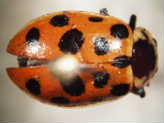
Hippodamia tredecimpunctata, commonly known as the thirteen-spot ladybeetle, is a species of lady beetle.
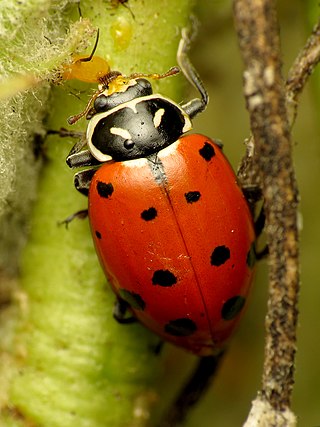
Hippodamia convergens, commonly known as the convergent lady beetle, is one of the most common lady beetles in North America and is found throughout the continent. They tend to live a variety of habitats, including grasslands and forests.
Coccinella novemnotata, the nine-spotted ladybug or nine-spotted lady beetle or C9, is a species of ladybug in the family Coccinellidae native to North America. This beetle was once ubiquitous across the continent but experienced a sharp and drastic decline around the 1960’s. Now, considered a rare species, the nine-spotted ladybug has received much attention from researchers who wish to understand the causes of its decline and restore the population of this charismatic beetle to benefit from their aphidophagous nature as biocontrol agents in agriculture.

Coccinella septempunctata, the seven-spot ladybird, is a carnivorous beetle native to the Old World and is the most common ladybird in Europe. The beetle is also found in North America, Central and Eastern Asia and regions with a temperate climate. Its elytra are of a red colour, but each punctuated with three black spots, with one further spot being spread over the junction of the two, making a total of seven spots, from which the species derives both its common and scientific names.
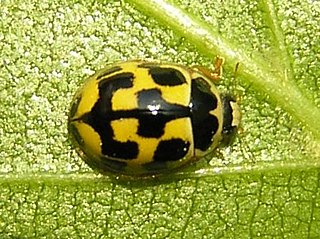
Propylea quatuordecimpunctata is a small lady beetle, belonging to the family Coccinellidae. It is sometimes referred to by the common name 14-spotted ladybird beetle, or simply P-14.

Coccinellidae is a widespread family of small beetles. They are commonly known as ladybugs in North America and ladybirds in the United Kingdom; "lady" refers to mother Mary. Entomologists use the names ladybird beetles or lady beetles to avoid confusion with true bugs. The more than 6,000 described species have a global distribution and are found in a variety of habitats. They are oval beetles with a domed back and flat underside. Many of the species have conspicuous aposematic (warning) colours and patterns, such as red with black spots, that warn potential predators that they taste bad.

Coccinella undecimpunctata, the eleven-spot ladybird or eleven-spotted lady beetle, it is native to central Asia, though commonly found in Europe, and formerly North America as its populations are decreasing. It is of the family Coccinellidae, commonly referred to as ladybugs or lady beetles.

Cryptolaemus montrouzieri, common name mealybug ladybird or mealybug destroyer, is a species of ladybird beetle native to eastern Australia. The beetle feeds on mealybugs and other scale insects, and is used to control those pests on citrus orchards worldwide.
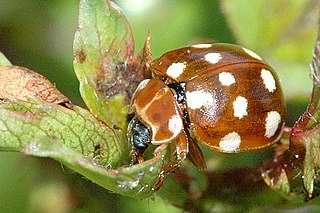
Calvia quatuordecimguttata, the cream-spot ladybird, is a species of ladybird in the family Coccinellidae. Its distribution is holarctic, it being found in Europe and through the East Palearctic to Japan. It is introduced to North America. This ladybird is generally 4 to 5 millimetres in length and varies in appearance depending on the geographical location. It usually lives in hedgerows and deciduous trees.

Coleomegilla maculata, commonly known as the spotted lady beetle, pink spotted lady beetle or twelve-spotted lady beetle, is a large coccinellid beetle native to North America. The adults and larvae feed primarily on aphids and the species has been used as a biological control agent. Based on name connotation and to avoid confusion with other species also called "spotted ladybeetle", spotted pink ladybeetle is probably the most appropriate common name for this species.
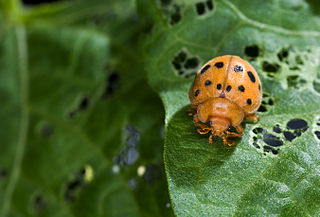
The Epilachninae are a subfamily of the family of lady beetles, the Coccinellidae, in the order Coleoptera. Superficially, they look much like other ladybirds in the larger subfamily Coccinellinae, but they differ importantly in their biology, in that the members of the subfamily are largely or completely leaf-feeding herbivores rather than being predators. Accordingly, several members of the subfamily are crop pests, and sometimes cause locally serious crop losses.

Cheilomenes is a genus of ladybirds (Coccinellidae). Like other members of their subfamily they are large typical ladybirds. They are always shiny and often have bright spots on the elytra. The common African species C. lunata is an important predator of the citrus aphid, Toxoptera, and wheat aphid, while C. vicina has been suggested as a biological control agent for the cowpea aphid. Both the larvae and adults are predatory. Freshly emerged larvae consume unhatched eggs, and eventually have a dappled appearance and 6 tubercles on each abdominal segment. Vulnerable stages in the life of C. sexmaculata, including oviposition, hatching, moulting and pupation have been shown to occur after dark, probably as an adaptation to avoid exposure to natural enemies.
Micraspis discolor is a species of ladybird. It was described by Johan Christian Fabricius in 1798. It is widespread throughout Asia, North America and parts of Oceania.
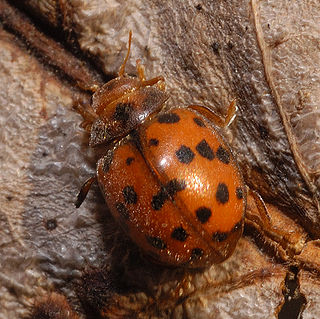
Subcoccinella vigintiquatuorpunctata is a beetle in the family Coccinellidae. It is the only member of the genus Subcoccinella. It has the typical, almost semi-spherical, ladybird shape and is patterned with spots. However it differs from many of the well-known ladybirds in being neither smooth and shiny nor an eater of aphids: the wing-cases look velvety and it eats fungal moulds on plants.

Harmonia testudinaria, commonly known as the tortoise-shelled ladybird, is a species of ladybird belonging to the family Coccinellidae. The tortoise shelled-ladybird occurs in Australia, New Guinea, Indonesia and Hawaii.

Olla v-nigrum is a species in the family Coccinellidae, in the suborder Polyphaga. The species is known generally as the ashy gray lady beetle. The distribution range of Olla v-nigrum includes Central America, North America, and Oceania. It is usually gray or pale tan with small black spots on its elytra and thorax. However, a variation can resemble Chilocorus orbus, another species of lady beetle. This form is black with two red spots on the wing covers and has white on the edge of the prothorax.
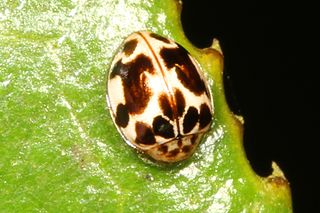
Psyllobora vigintimaculata, the twenty-spotted lady beetle, is a species of lady beetle in the family Coccinellidae. It is found in North America.

Henosepilachna argus, common name bryony ladybird, is a species of beetle in the family Coccinellidae.


















